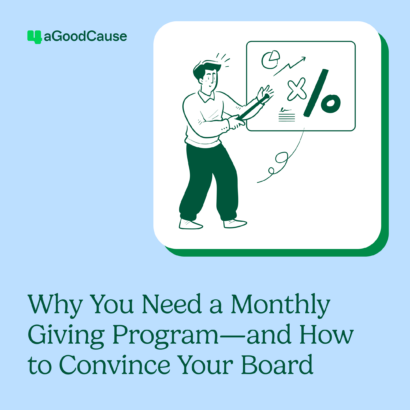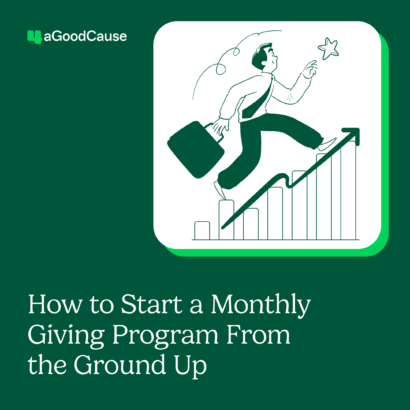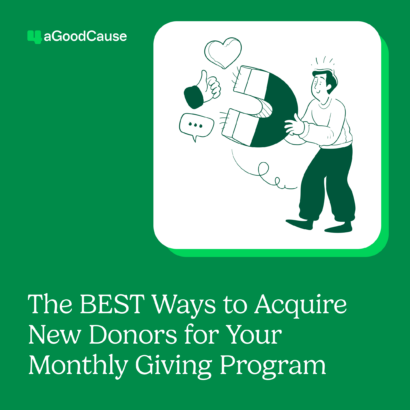When you think about donor acquisition, you may often be focused on securing a first-time donation. But did you know that securing your donor’s second gift is an essential part of your nonprofit’s fundraising stability? As Mary Cahalane mentioned in her donor retention webinar, 80% of donors are lost between the first and second gift and it’s more expensive to acquire new donors versus retaining existing ones—five to seven times more. A second gift from a donor is not only cost-effective but also an indication that they believe in your organization and support your cause enough to continue giving.
So, when is the right time to ask for subsequent gifts? How can you establish relationships with your donors to tee things up for a second donation? Here are some ways to set the stage for a strong donor relationship and make that second gift ask.
1. Remember to say, “thank you.”
A timely thank you after the first donation is very important and your first step in securing a second gift. You don’t want to go too long before acknowledging that you received a donor’s gift. Automate your donor thank you process within your online donation system and ensure that your donors who give by traditional means (e.g., mailed donation checks) receive a thank you within 48 hours of that first donation. Recognize donors by name and thank them for the dollar amount they gave. Let them know their gift made a difference and provide stats or an impact story to back that up. You could also reach out to them by calling, writing a handwritten note or sending a welcome package with small ‘swag’ gifts from your organization. Thank you notes should be prompt, personable, emotional and specific. It’s a conversation you want to keep going.
2. Report back and ask for feedback.
Let your donors know how their contribution has continued to support your organization. This can be through a newsletter that showcases how close you are to achieving an annual goal or how specific donations were used. Use stories of impact to showcase success and continue to drive donor relationships. Include cheerful faces, large headlines, direct verbiage and a focus on the word “you” to showcase donors (not just the organization).
Incorporating feedback from your supporters also makes them feel personally involved in your organization. Send a survey with a few short questions and have them be a guide in what they like, dislike or look forward to from your nonprofit. Ask for comments and engagement on your social media channels or give them an opportunity to reply to your monthly emails or e-newsletters. Show your donors that you value their opinions and are available to answer questions or provide additional information.
3. Engage with your donors.
Engagement is key for donors. Give them a chance to be a part of your cause by showcasing where you are online (social media, email, web) and in-person (special events, community building). You can also open volunteer opportunities (committees, hosts, planners) to first-time donors to show with a hands-on approach how great your organization is. Offering ways to support the mission in non-financial ways can result in a second gift.
4. Keep communication consistent and open.
If you want to secure a second gift in a timely manner, it is important to keep the communication going. Ask your donors to join your newsletter or encourage them to follow you on social media. You want to make you stay top of mind and that they are continuously keeping up with your activities and can see the impact you are creating. Showing them how their donation is being used can result in a second donation.
5. Make the ask.
Once you create the connection to your donors and they see the difference you are making, they will want to continue to support. Don’t go too long without asking for a second gift but be sure to not ask for a donation at every touchpoint. It’s important to build a relationship and earn long-term support. Your donor’s enthusiasm for the cause will result in the organization’s growth.
Focus your messaging on what the donor can do or change with his or her donation versus your need for money. Showcasing how their donation makes a difference (e.g., number of backpacks purchased, pounds of foods served, number of mentors provided, etc.) puts a number to their dollar amounts.
In addition, if your first-time donors made a one-time gift, you can showcase the impact of how a recurring or monthly gift this time around can stretch their dollars even farther.
Asking for a second gift could be done over email, phone or by setting up a one-on-one meeting. When asking for a second-time gift, acknowledge the last time they donated and the amount, their engagement with the organization and a reminder about why they donated the first time.
Strategies for making a second-time gift ask:
- Ask for a modest dollar contribution
- Ask for a specific program or issue that concerns them
- Ask for a matching gift
- Ask to turn their one-time gift into recurring, monthly giving
No matter your strategy, set a process to measure your fundraising success. Start analyzing when people left and how to get them back—this can be by dollar amount, by the number of donations or by communication channels (e.g., newsletter unsubscribes, abandoned website pages/carts, etc.). If you make your second-gift campaigns an annual strategy, assess how successful one is over the other or if there were deciding factors that seemed to make others give a second time over not giving again. The more you know and track your donors’ giving habits and timelines, the more successful you will be for those second-time asks.



